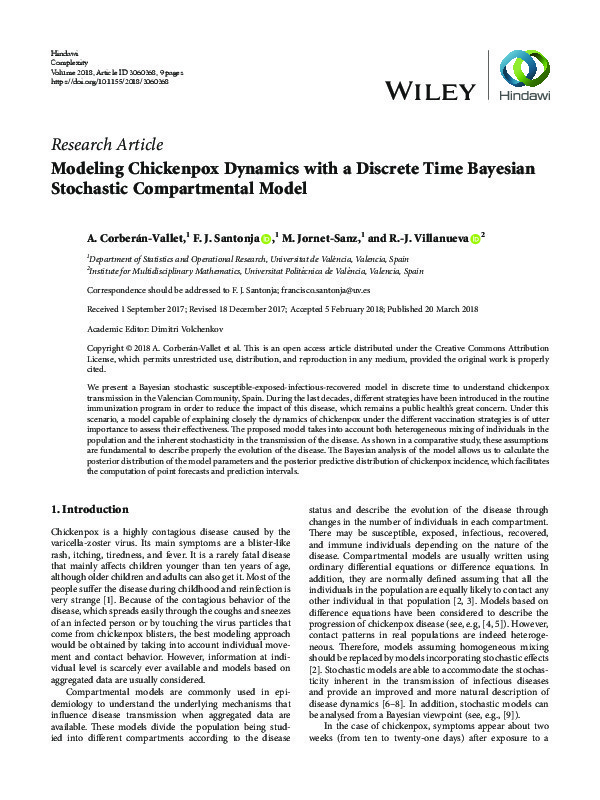JavaScript is disabled for your browser. Some features of this site may not work without it.
Buscar en RiuNet
Listar
Mi cuenta
Estadísticas
Ayuda RiuNet
Admin. UPV
Modeling Chickenpox Dynamics with a Discrete Time Bayesian Stochastic Compartmental Model
Mostrar el registro sencillo del ítem
Ficheros en el ítem
| dc.contributor.author | Corberán-Vallet, Ana
|
es_ES |
| dc.contributor.author | Santonja, F.
|
es_ES |
| dc.contributor.author | Jornet-Sanz, Marc
|
es_ES |
| dc.contributor.author | Villanueva Micó, Rafael Jacinto
|
es_ES |
| dc.date.accessioned | 2020-05-22T03:02:12Z | |
| dc.date.available | 2020-05-22T03:02:12Z | |
| dc.date.issued | 2018-03-20 | es_ES |
| dc.identifier.issn | 1076-2787 | es_ES |
| dc.identifier.uri | http://hdl.handle.net/10251/144078 | |
| dc.description.abstract | [EN] We present a Bayesian stochastic susceptible-exposed-infectious-recovered model in discrete time to understand chickenpox transmission in the Valencian Community, Spain. During the last decades, different strategies have been introduced in the routine immunization program in order to reduce the impact of this disease, which remains a public health's great concern. Under this scenario, a model capable of explaining closely the dynamics of chickenpox under the different vaccination strategies is of utter importance to assess their effectiveness. The proposed model takes into account both heterogeneous mixing of individuals in the population and the inherent stochasticity in the transmission of the disease. As shown in a comparative study, these assumptions are fundamental to describe properly the evolution of the disease. The Bayesian analysis of the model allows us to calculate the posterior distribution of the model parameters and the posterior predictive distribution of chickenpox incidence, which facilitates the computation of point forecasts and prediction intervals. | es_ES |
| dc.description.sponsorship | This work has been supported by a research grant from the Spanish Ministry of Economy and Competitiveness (MTM2017-83850-P). | es_ES |
| dc.language | Inglés | es_ES |
| dc.publisher | John Wiley & Sons | es_ES |
| dc.relation.ispartof | Complexity | es_ES |
| dc.rights | Reconocimiento (by) | es_ES |
| dc.subject.classification | MATEMATICA APLICADA | es_ES |
| dc.title | Modeling Chickenpox Dynamics with a Discrete Time Bayesian Stochastic Compartmental Model | es_ES |
| dc.type | Artículo | es_ES |
| dc.identifier.doi | 10.1155/2018/3060368 | es_ES |
| dc.relation.projectID | info:eu-repo/grantAgreement/AEI/Plan Estatal de Investigación Científica y Técnica y de Innovación 2013-2016/MTM2017-83850-P/ES/PREDICCION Y OPTIMIZACION BAJO INCERTIDUMBRE: MODELOS ESTOCASTICOS DINAMICOS Y APLICACIONES (2)/ | es_ES |
| dc.rights.accessRights | Abierto | es_ES |
| dc.contributor.affiliation | Universitat Politècnica de València. Departamento de Matemática Aplicada - Departament de Matemàtica Aplicada | es_ES |
| dc.description.bibliographicCitation | Corberán-Vallet, A.; Santonja, F.; Jornet-Sanz, M.; Villanueva Micó, RJ. (2018). Modeling Chickenpox Dynamics with a Discrete Time Bayesian Stochastic Compartmental Model. Complexity. 1-9. https://doi.org/10.1155/2018/3060368 | es_ES |
| dc.description.accrualMethod | S | es_ES |
| dc.relation.publisherversion | https://doi.org/10.1155/2018/3060368 | es_ES |
| dc.description.upvformatpinicio | 1 | es_ES |
| dc.description.upvformatpfin | 9 | es_ES |
| dc.type.version | info:eu-repo/semantics/publishedVersion | es_ES |
| dc.relation.pasarela | S\363084 | es_ES |
| dc.contributor.funder | Agencia Estatal de Investigación | es_ES |
| dc.description.references | Acedo, L., Moraño, J.-A., Santonja, F.-J., & Villanueva, R.-J. (2016). A deterministic model for highly contagious diseases: The case of varicella. Physica A: Statistical Mechanics and its Applications, 450, 278-286. doi:10.1016/j.physa.2015.12.153 | es_ES |
| dc.description.references | Díez-Gandía, A., Villanueva, R.-J., Moraño, J.-A., Acedo, L., Mollar, J., & Díez-Domingo, J. (2016). Studying the Herd Immunity Effect of the Varicella Vaccine in the Community of Valencia, Spain. Lecture Notes in Computer Science, 38-46. doi:10.1007/978-3-319-31744-1_4 | es_ES |
| dc.description.references | Stochastic epidemic models with a backward bifurcation. (2006). Mathematical Biosciences and Engineering, 3(3), 445-458. doi:10.3934/mbe.2006.3.445 | es_ES |
| dc.description.references | Roberts, M., Andreasen, V., Lloyd, A., & Pellis, L. (2015). Nine challenges for deterministic epidemic models. Epidemics, 10, 49-53. doi:10.1016/j.epidem.2014.09.006 | es_ES |
| dc.description.references | Corberán-Vallet, A., & Santonja, F. J. (2014). A Bayesian SIRS model for the analysis of respiratory syncytial virus in the region of Valencia, Spain. Biometrical Journal, 56(5), 808-818. doi:10.1002/bimj.201300194 | es_ES |
| dc.description.references | Bjørnstad, O. N., Finkenstädt, B. F., & Grenfell, B. T. (2002). DYNAMICS OF MEASLES EPIDEMICS: ESTIMATING SCALING OF TRANSMISSION RATES USING A TIME SERIES SIR MODEL. Ecological Monographs, 72(2), 169-184. doi:10.1890/0012-9615(2002)072[0169:domees]2.0.co;2 | es_ES |
| dc.description.references | Gelman, A. (2006). Prior distributions for variance parameters in hierarchical models (comment on article by Browne and Draper). Bayesian Analysis, 1(3), 515-534. doi:10.1214/06-ba117a | es_ES |
| dc.description.references | Lunn, D., Spiegelhalter, D., Thomas, A., & Best, N. (2009). Rejoinder to commentaries on ‘The BUGS project: Evolution, critique and future directions’. Statistics in Medicine, 28(25), 3081-3082. doi:10.1002/sim.3691 | es_ES |








